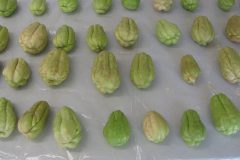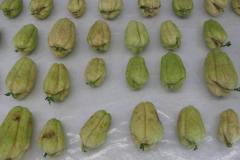 Sprouting mirlitons (Sechium edule). These are all "Mister Rock Variety." To get fresh mirlitons to sprout, keep at 80-85 degrees F. out of direct sun and protected from insects (these were sprayed with sulfur). The warmth will literally "incubate" the mirltions into sprouting within two weeks. This were stored in a room during the winter that averaged about 65 degrees F. and took several week to sprout. Sprouting is also induced by humidity, so another technique is to place vertically, large end pointing down, in a large plastic storage tub and cover with a lid. You can use a small plastic trash can if you only have a few to sprouts. (see next photo caption)
Sprouting mirlitons (Sechium edule). These are all "Mister Rock Variety." To get fresh mirlitons to sprout, keep at 80-85 degrees F. out of direct sun and protected from insects (these were sprayed with sulfur). The warmth will literally "incubate" the mirltions into sprouting within two weeks. This were stored in a room during the winter that averaged about 65 degrees F. and took several week to sprout. Sprouting is also induced by humidity, so another technique is to place vertically, large end pointing down, in a large plastic storage tub and cover with a lid. You can use a small plastic trash can if you only have a few to sprouts. (see next photo caption)
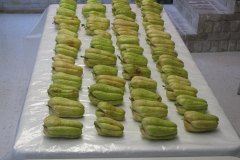 Keep at 80-85 F. 24 hours a day--you may need to use a heat pad under the tub for indirect heat. If you do, place a few pieces of wood in the bottom (or any non-conducting material) so the mirlitons don't come into direct contact with heated bottom. Place the thermometer in the middle of the stack and not touching the bottom.
Keep at 80-85 F. 24 hours a day--you may need to use a heat pad under the tub for indirect heat. If you do, place a few pieces of wood in the bottom (or any non-conducting material) so the mirlitons don't come into direct contact with heated bottom. Place the thermometer in the middle of the stack and not touching the bottom.
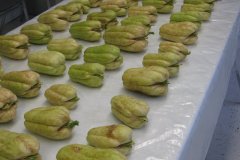 Mirlitons sprouting in relatively cool room inside. They took several weeks to sprout during October and November. These were Mister Rock Variety
Perfect sprout for planting. All that needs to happen is that the internal seed is extruded through the large end, exposing the tip of the seed where the roots will emerge and the first shoot growth. This is ready to plant.
Various stages of sprouting. Note that smaller fruit sprouts just as well as large. Various stages of sprouting. Note that smaller fruit sprouts just as well as large.
Before these began to sprout, they were sprayed with flow-able organic sulfur to eliminate pests and fungi. Don't spray after the shoot and roots appear or the sulfur can damage
Mirlitons sprouting in relatively cool room inside. They took several weeks to sprout during October and November. These were Mister Rock Variety
Perfect sprout for planting. All that needs to happen is that the internal seed is extruded through the large end, exposing the tip of the seed where the roots will emerge and the first shoot growth. This is ready to plant.
Various stages of sprouting. Note that smaller fruit sprouts just as well as large. Various stages of sprouting. Note that smaller fruit sprouts just as well as large.
Before these began to sprout, they were sprayed with flow-able organic sulfur to eliminate pests and fungi. Don't spray after the shoot and roots appear or the sulfur can damage
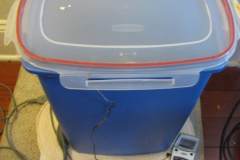 Sprouting mirlitons (Sechium edule). These are all "Mister Rock Variety." To get fresh mirlitons to sprout, keep at 80-85 degrees F. for out of direct sun and protected from insects (these were sprayed with sulfur). The warmth will literally "incubate" the mirlitons into sprouting within two weeks. These were stored in a room during the winter that averaged about 65 degrees F. and took several week to sprout. Sprouting is also induced by humidity, so another technique is to place vertically, large end pointing down, in a large plastic storage tub and cover with a lid. You can use a small plastic trash can if you only have a few to sprouts. Keep at 80-85 F. 24 hours a day--you may need to use a heat pad under the tub for indirect heat. If you do, place a few pieces of wood in the bottom (or any non-conducting material) so the mirlitons don't come into direct contact with heated bottom. Place the thermometer in the middle of the stack and not touching the bottom. See next photo caption.
Sprouting mirlitons (Sechium edule). These are all "Mister Rock Variety." To get fresh mirlitons to sprout, keep at 80-85 degrees F. for out of direct sun and protected from insects (these were sprayed with sulfur). The warmth will literally "incubate" the mirlitons into sprouting within two weeks. These were stored in a room during the winter that averaged about 65 degrees F. and took several week to sprout. Sprouting is also induced by humidity, so another technique is to place vertically, large end pointing down, in a large plastic storage tub and cover with a lid. You can use a small plastic trash can if you only have a few to sprouts. Keep at 80-85 F. 24 hours a day--you may need to use a heat pad under the tub for indirect heat. If you do, place a few pieces of wood in the bottom (or any non-conducting material) so the mirlitons don't come into direct contact with heated bottom. Place the thermometer in the middle of the stack and not touching the bottom. See next photo caption.
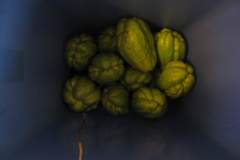 Mirlitons "incubating" in plastic container with heating pad and remote thermometer. Temperature inside container kept at 80-85 degrees F. Lid used to maintain humidity which encourages sprouting and reduce dehydration of seed. This was kept in the house when nights were in the 60s and then moved outside on a wire rack during the day when temperatures were in the 80s. Half of the mirlitons had extruded the seed through the large end in 12 days which is much faster than if kept inside at room temperature. The seeds can be planted once the internal seed has emerged and a small green shoot has begun to emerge from the seed.
Inside view of incubating container. Mirlitons stacked vertically so sprouts can emerge in container (these are stacked wrong! They should be "big end pointing down). Thermometer placed in the middle of the stack. Inside view of incubating container. Mirlitons stacked vertically so sprouts can emerge in container (these are stacked wrong! They should be "big end pointing down). Thermometer placed in the middle of the stack.
Mirlitons "incubating" in plastic container with heating pad and remote thermometer. Temperature inside container kept at 80-85 degrees F. Lid used to maintain humidity which encourages sprouting and reduce dehydration of seed. This was kept in the house when nights were in the 60s and then moved outside on a wire rack during the day when temperatures were in the 80s. Half of the mirlitons had extruded the seed through the large end in 12 days which is much faster than if kept inside at room temperature. The seeds can be planted once the internal seed has emerged and a small green shoot has begun to emerge from the seed.
Inside view of incubating container. Mirlitons stacked vertically so sprouts can emerge in container (these are stacked wrong! They should be "big end pointing down). Thermometer placed in the middle of the stack. Inside view of incubating container. Mirlitons stacked vertically so sprouts can emerge in container (these are stacked wrong! They should be "big end pointing down). Thermometer placed in the middle of the stack.




